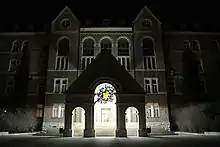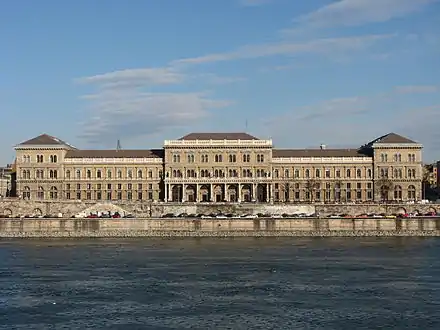University of Pécs
The University of Pécs (PTE; Hungarian: Pécsi Tudományegyetem) is an institution of higher education in Hungary. Although the year 1367 appears in the seal of the university, it is not a successor of the medieval university founded in Pécs in 1367 by Louis I of Hungary. More than 20,000 students presently attend the University of Pécs, approximately 4,000 of whom are international students studying in English or German.[3][4]
Pécsi Tudományegyetem[1] | |
 | |
| Latin: Universitas Quinqueecclesiensis | |
| Type | Public |
|---|---|
| Established | 1912 (claiming 1367) |
| Rector | Dr Attila Miseta |
Academic staff | 1854 |
| Students | 20,000[2] |
| Location | , |
| Campus | Urban |
| Affiliations | Compostela Group of Universities |
| Website | international |
History

The first university of Hungary was established in Pécs by Louis I of Hungary in 1367,[5] the letters patent issued by pope Urban V, similar to that of the University of Vienna. The university existed for a few decades, then split into two schools, one of jurisprudence and one of theology in the course of the 15th century. The university was completely discontinued during Ottoman occupation, then restarted in 1785 by Joseph II moving the Royal Academy from Győr to Pecs. In 1802 the Royal Academy was moved back to Győr by the order of Francis I, and higher education was discontinued in Pecs until 1833, when the bishop of Pecs in conjunction with the city senate founded the Pecs Academy, comprising a legal and a philosophical faculty.
The modern University of Pécs was founded in 1912, and was originally located in Pozsony (now Bratislava, Slovakia). Following World War I Pozsony became part of the newly formed Czechoslovakia. In 1921, the university moved to Pécs, where it remained to this day. In 1951 the medical faculty was separated from the university, and till 2000 was a separate institution. The university was renamed Janus Pannnonius University in 1982. The present University of Pécs was created on January 1, 2000, via the merger of Janus Pannonius University, the Medical University of Pécs and the Illyés Gyula Teacher Training College of Szekszárd.
Medical School
After World War I, when Hungary lost most of its territory, the university was re-established in 1923 from Elisabeth (Erzsébet) University which escaped from the city of Pozsony (Bratislava, presently the capital city of Slovakia). The Elisabeth University of Sciences had four faculties (Arts, Law, Medicine and Theology) with several outstanding professors teaching in the Medical School (Pál Heim, Béla Entz, Géza Mansfeld, just to mention a few of them). In 1951 the Medical School became a separate, independent institution under the name of the Medical University of Pécs. It underwent substantial infrastructural development in the 1960s and 1970s: the new clinical and basic science blocks were built during this period. Besides the general medicine program, training in dentistry and pharmacy were launched in 1973 and 2001. Meanwhile, the English Program in General Medicine was implemented in 1984, the first medical education program of its kind in Central Europe. A similar German Program was initiated in 2004.[6]
School shooting
A shooting occurred at the University of Pécs in November 2009. A student died in the shooting and three were wounded. The perpetrator was a first year pharmacy student. He was quickly apprehended by the police.[7]
See also
References
- "University of Pécs - Study in Hungary". Retrieved 20 December 2016.
- "Facts & figures about the UP - Pécsi Tudományegyetem". Retrieved 20 December 2016.
- https://pte.hu/english/our_university
- http://international.pte.hu/information_parents
- Ana səhifə
- ÁOK, PTE. "PTE ÁOK Felvételi Portál - Főoldal". Retrieved 20 December 2016.
- News article.
Bibliography
- Pécsi Tudományegyetem: University of Pécs, 1367. Eds.: Harka, Glass. Pécs: UP, 2007.
- Fényes, Miklós. Középkori egyetemek Magyarországon, A Pécsi Egyetem története. In: Bibliographie internationale l'histoire des Universités II. Genève: Librairie Droz, 1976.
- Petrovics, István. A középkori pécsi egyetem és alapítója. Aetas, 2005-04. 2.
- Kéri, Katalin, dr. A pécsi egyetem a középkorban. (In: Napi Magyarország, 1998. március 7., 16. o.)
- Az orvosi kar története. http://aok.pte.hu/index.php?page=html&h=tortenet_hosszu
External links
- International website of the University of Pécs (in English)
